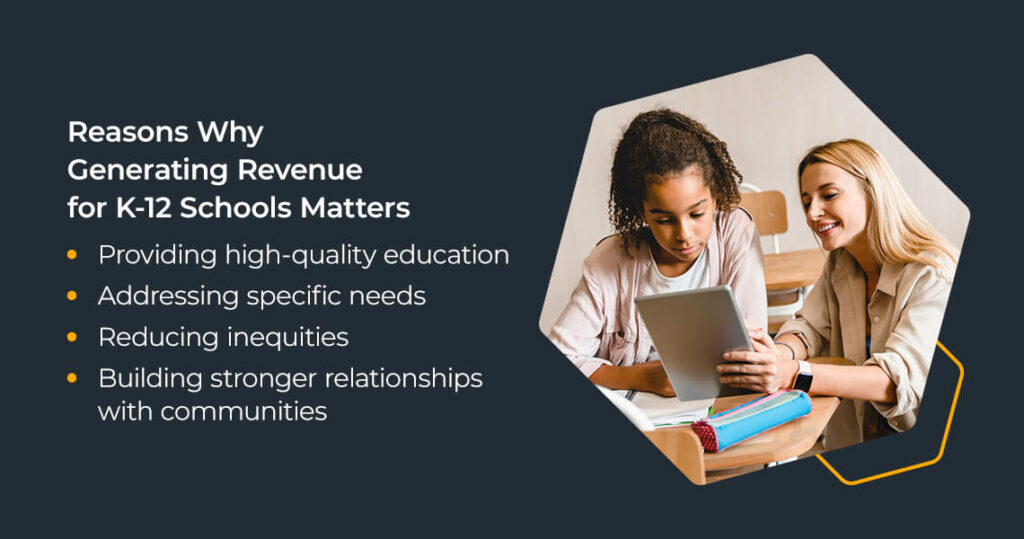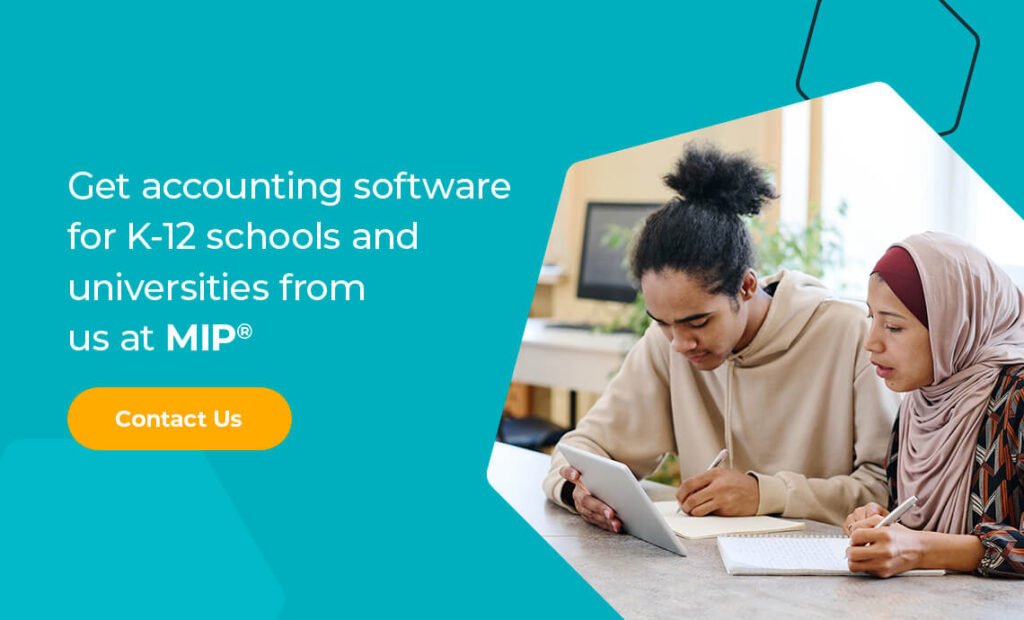Reading Time: 5 minutes
K-12 schools across the country face many challenges, one of the most pressing being funding. With tight budgets and limited resources, schools often struggle to provide the education and services that students need. Fortunately, several creative ways can generate revenue for K-12 schools to help boost funding and improve the educational experience for students.
How Is K-12 Funded?
Federal funding for K-12 schools in the United States is primarily provided through several programs administered by the U.S. Department of Education. Some of the main federal funding programs for K-12 schools include:
- Title I funding: This program provides funding to schools with high numbers or high percentages of low-income students to help improve educational outcomes for these students. Title I funding can be used for a variety of purposes, including hiring additional teachers and staff, providing professional development for educators, and purchasing instructional materials and technology.
- Individuals with Disabilities Education Act (IDEA) Funding: This program provides funding to help support special education services and programs for students with disabilities. IDEA funding can be used for a range of purposes, including hiring special education teachers and staff, providing assistive technology and other specialized equipment, and developing individualized education plans (IEPs) for students.
- School meal programs: The federal government provides funding to support school meal programs, including the National School Lunch Program and the School Breakfast Program. These programs help ensure that all students have access to nutritious meals during the school day.
- School safety programs: The federal government also provides funding for school safety programs, including programs to prevent bullying and harassment, promote school safety and security, and support mental health services for students.
The federal government also provides funding for a range of other initiatives to support K-12 education, including programs to support STEM education, English language learners, and school improvement efforts. However, the exact amount of federal funding that each school or district receives can vary depending on a range of factors, including the size of the school or district, the demographics of the student population, and the state and local funding available.
Alternative Revenue for K-12 Schools
Alternative revenue streams for K-12 schools include:
- Grant writing: Grant writing is one of the most effective ways to generate revenue for K-12 schools. There are many foundations and organizations that offer grants to schools for various purposes, including technology upgrades, curriculum development, and professional development for teachers. However, writing a successful grant application requires time, effort, and expertise.
- Fundraising: Fundraising is a tried-and-true method for generating revenue for K-12 schools. From bake sales and car washes to auctions and benefit concerts, there are many ways to raise money for schools. In recent years, crowdfunding platforms like GoFundMe have also become popular for school fundraising.
- Corporate partnerships: Corporate partnerships can be a win-win for K-12 schools and businesses. Schools can benefit from financial support, while businesses can enhance their brand reputation and build goodwill in the community. Some corporate partnerships may involve donations or sponsorships, while others may involve in-kind support, such as volunteer hours or donated goods.
- Facility rentals: Schools can generate revenue by renting out their facilities for events and activities. This can include renting out gymnasiums, auditoriums, or other spaces for sports leagues, community events, or other activities. Schools can also rent out their facilities during the summer months when they are not in use.
- Educational programs: Some schools have found success in generating revenue by offering educational programs and services to the community. This can include after-school programs, tutoring services, or summer camps. By charging fees for these programs, schools can generate revenue while also providing valuable services to students and families.
Why Generating Revenue for K-12 Schools Matters

Generating revenue for K-12 schools is important for several reasons.
- Providing high-quality education: First and foremost, adequate funding is essential to providing high-quality education and supporting student success. Without sufficient resources, schools may struggle to provide the necessary materials, equipment, and programs that are critical to student learning and development.
- Addressing specific needs: In addition, generating revenue can help schools to address specific needs and priorities that may not be fully supported by traditional funding sources. For example, schools may use additional revenue to invest in technology infrastructure, hire additional staff or specialists, or provide extracurricular programs that support student interests and engagement.
- Reducing inequities: Generating revenue can also help to reduce inequities and ensure that all students have access to the resources and opportunities they need to succeed. Schools in low-income areas or with high percentages of disadvantaged students may face significant challenges in securing adequate funding, and alternative revenue sources can help to address these disparities.
- Building stronger relationships with communities: Generating revenue can help schools to build stronger relationships with their communities and engage families and stakeholders in supporting student success. By working together to identify and support alternative revenue sources, schools can demonstrate their commitment to providing high-quality education and helping students to achieve their full potential.
Use School Funding More Efficiently
Here are some ways that K-12 schools can use their funding more efficiently:
- Conduct a comprehensive review of spending: Schools should conduct a comprehensive review of their spending to identify areas where they can cut costs and redirect funds to support higher-priority initiatives. This can involve analyzing data on spending and student outcomes, as well as engaging stakeholders to gather input and feedback.
- Implement cost-saving strategies: Schools can implement cost-saving strategies to reduce expenditures and free up funds for other initiatives. This can include strategies such as bulk purchasing, energy efficiency upgrades, and reducing administrative costs.
- Prioritize high-impact initiatives: Schools should prioritize high-impact initiatives that have been proven to support student success and achievement. This can involve investing in programs and services that have a track record of success and align with the school’s goals and priorities.
- Leverage technology: Technology can be a powerful tool for improving efficiency and reducing costs in schools. Schools can leverage technology to streamline administrative processes, automate routine tasks, and provide students with personalized learning experiences.
- Build partnerships: Schools can build partnerships with businesses, nonprofits, and other organizations to access additional resources and support. Partnerships can provide access to funding, expertise, and other resources that can help schools to achieve their goals more efficiently.
By implementing these strategies, K-12 schools can use their funding more efficiently and effectively, allowing them to better support student success and achievement.
How to Increase Funding
Increasing funding for K-12 schools can be a challenging task, but here are some possible strategies that schools and advocates may consider:
- Lobbying for state and federal funding: K-12 schools can lobby their state and federal representatives to increase funding for education. This can involve participating in advocacy efforts and communicating the importance of funding for student success and achievement.
- Bond referendums: Schools can hold bond referendums to generate funds for specific capital projects, such as building renovations or upgrades to technology infrastructure. Bond referendums require voter approval, but they can provide a significant source of funding for schools.
- Public-private partnerships: Schools can build partnerships with private organizations to support specific programs and initiatives. These partnerships can provide funding, expertise, and other resources to support student success and achievement.
- Seek grants: Schools can seek grants from a variety of sources, including foundations, corporations, and government agencies. Grants can provide funding for specific programs or initiatives, and they may also provide opportunities for professional development and capacity-building.
- Consider parent and community contributions: Schools can encourage parent and community contributions to support school programs and initiatives. This can involve fundraising events or campaigns, as well as encouraging volunteerism and in-kind contributions.
Ultimately, increasing funding for K-12 schools will require a multifaceted approach that involves advocacy, creativity, and collaboration. By working together to identify and leverage resources, schools can provide the support and resources necessary for students to succeed and thrive.
Learn More About Fundraising Revenue

K-12 schools face many challenges when it comes to funding, but there are several creative ways to generate revenue. By exploring these strategies, schools can provide the education and services that students need while also improving their financial situation. Get accounting software for K-12 schools and universities from us at MIP®.
Share this post





